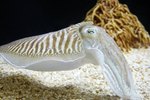
Squid appear graceful as they glide through the water, often in large groups. Their peaceful appearance is deceiving, however. Squid are fierce predators, and many aren't afraid to attack human divers when the opportunity arises. Their strong tentacles can grab divers and pull them down, disorienting them while cutting through wetsuits and skin with sharp teeth and claws.
Numbers
Squid can be dangerous because of their sheer numbers. They often travel in groups; one of the most aggressive species, the Humboldt squid, can live in groups of up to 1,200 animals. The numbers of aggressive squid appear to be growing near inhabited beaches, making them even more dangerous for swimmers and divers, especially at night when squid move up toward the surface. For example, ABC News in Los Angeles reports an explosion in the squid population off the southern California coast, likely a result of overfishing of squid predators such as marlin and sharks.
Aggression
Squid are aggressive hunters, but some species are worse than others. The Humboldt squid is of particular danger to divers because it's large -- about the size of a man -- and shows little fear or hesitation when hunting prey. Colossal squid are just as aggressive and fast hunters, and they top out at 2,000 pounds. Thankfully, these giant sea creatures tend to stay in deeper water away from where humans typically dive.
Camouflage
When trying to avoid squid, divers might look for the telltale oblong shape and colors such as red or white. What makes squid dangerous is that their colors aren't constant. They have the ability to change color almost instantaneously to match their environment. If you spot a squid while diving, you could lose sight of him quickly as he morphs to blend in with the background. He can hit you from what seems like out of nowhere.
Teeth, Beaks and Claws
Many squid have more than suction cups on their tentacles -- they have sharp teeth or claws to grab prey. When a Humboldt squid grabs a diver, for example, he engages teeth that ring each suction cup. Each squid can have up to 35,000 teeth. These sharp teeth bite through protective swim gear to grasp and tear flesh. Squid with claws can rip and tear through your suit and skin. Squid also have sharp beaks designed to pierce the hard flesh and exoskeletons of sea creatures; your skin isn't a match for this strong mouthpiece.
References
Photo Credits
-
Comstock Images/Comstock/Getty Images




